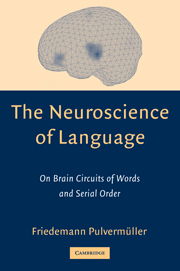Book contents
- Frontmatter
- Contents
- Preface
- The Neuroscience of Language
- 1 A Guide to the Book
- 2 Neuronal Structure and Function
- 3 From Classic Aphasia Research to Modern Neuroimaging
- 4 Words in the Brain
- Excursus E1 Explaining Neuropsychological Double Dissociations
- 5 Regulation, Overlap, and Web Tails
- 6 Neural Algorithms and Neural Networks
- 7 Basic Syntax
- 8 Synfire Chains as the Basis of Serial Order in the Brain
- 9 Sequence Detectors
- 10 Neuronal Grammar
- 11 Neuronal Grammar and Algorithms
- Excursus E2 Basic Bits of Neuronal Grammar
- Excursus E3 A Web Response to a Sentence
- 12 Refining Neuronal Grammar
- Excursus E4 Multiple Reverberation for Resolving Lexical Ambiguity
- Excursus E5 Multiple Reverberations and Multiple Center Embeddings
- 13 Neurophysiology of Syntax
- 14 Linguistics and the Brain
- References
- Abbreviations
- Author Index
- Subject Index
Preface
Published online by Cambridge University Press: 15 December 2009
- Frontmatter
- Contents
- Preface
- The Neuroscience of Language
- 1 A Guide to the Book
- 2 Neuronal Structure and Function
- 3 From Classic Aphasia Research to Modern Neuroimaging
- 4 Words in the Brain
- Excursus E1 Explaining Neuropsychological Double Dissociations
- 5 Regulation, Overlap, and Web Tails
- 6 Neural Algorithms and Neural Networks
- 7 Basic Syntax
- 8 Synfire Chains as the Basis of Serial Order in the Brain
- 9 Sequence Detectors
- 10 Neuronal Grammar
- 11 Neuronal Grammar and Algorithms
- Excursus E2 Basic Bits of Neuronal Grammar
- Excursus E3 A Web Response to a Sentence
- 12 Refining Neuronal Grammar
- Excursus E4 Multiple Reverberation for Resolving Lexical Ambiguity
- Excursus E5 Multiple Reverberations and Multiple Center Embeddings
- 13 Neurophysiology of Syntax
- 14 Linguistics and the Brain
- References
- Abbreviations
- Author Index
- Subject Index
Summary
How is language organized in the human brain? This book provides results of brain activation studies, facts from patients with brain lesions, and hints from computer simulations of neural networks that help answer this question. Great effort was spent to spell out the putative neurobiological basis of words and sentences in terms of nerve cells, or neurons. The neuronal mechanisms – that is, the nerve cell wiring of language in the brain – are actually in the focus. This means that facts about the activation of cortical areas, about the linguistic deficits following brain disease, and the outcome of neural network simulations will always be related to neuronal circuits that could explain them, or, at least, could be their concrete organic counterpart in the brain.
In cognitive neuroscience, the following questions are commonly asked with regard to various higher brain functions, or cognitive processes, including language processes:
Where? In which areas of the brain is a particular process located?
When? Before and after which other processes does the particular process occur?
How? By which neuron circuit or which neuron network type is the particular process realized?
Why? On the basis of which biological or other principles is the particular process realized by this particular network, at this particular point in time, and at these particular brain loci?
The ultimate answer to the question of language and the brain implies answers to these questions, with respect to all aspects of language processing.
Information
- Type
- Chapter
- Information
- The Neuroscience of LanguageOn Brain Circuits of Words and Serial Order, pp. xi - xivPublisher: Cambridge University PressPrint publication year: 2003
